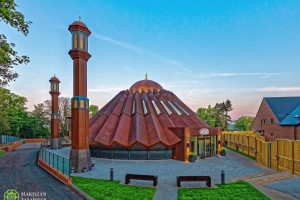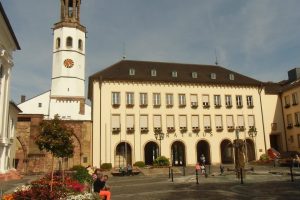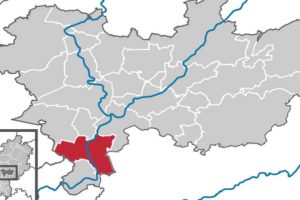YAHYA LUQMAN, USA

On 20th October, 2018, before departing the city of Philadelphia, His Holinessaba worldwide Head of the Ahmadiyya Muslim Community, made a brief stop at the historic Laurel Hill Cemetery. There, at almost a 100-year-old grave, he prayed for the soul of a pious and selfless man whose story would most certainly have been lost to history, had his name not been preserved in the writings of the Promised Messiahas as a sign of the fulfillment of God’s promise to him: ‘I shall cause thy message to spread to the corners of the earth.’
Anthony George Baker was born in Pittsburgh, Pennsylvania, on 2nd February 1849.1 The son of German immigrants, Dr Jacob Baker and Mary Catherine Platt, he always maintained a keen interest in his heritage and in later years wrote A History of the Germans in America.2
Growing up in Pittsburgh he received his early education in the Pittsburgh public schools and in 1869 graduated from the Western University of Pennsylvania (which afterwards became the University of Pittsburgh) with degrees of Bachelor of Arts and Master of Arts. He then entered the Western Theological Seminary, in Allegheny, Pennsylvania, and in 1873 graduated with a degree of Bachelor of Divinity and was ordained a minister of the Presbyterian Church.3
Rev. Baker’s first pastorate assignment was in Bardolph, Illinois, and by 1877, he was transferred to the only Presbyterian church in Atlantic City, New Jersey. Described as a ‘profound theological student’4 he continuously studied religion and examined his own faith. During his time in Atlantic City he found himself more inclined towards the doctrines of the Episcopal church. He soon ‘converted’ and became a deacon in the Episcopalian church, serving in 1878 as an assistant to the rector of St. George’s Church in Philadelphia, Pennsylvania. A year later he was ordained a priest and for the next few years worked as both an assistant rector and rector at several churches in Pennsylvania, and also founded St. Simeon’s Church in Philadelphia.5,6
While performing his duties as a clergyman he also studied at the Jefferson Medical College of Thomas Jefferson University and in 1887 graduated as a medical doctor specializing in pediatrics. At the relatively young age of 38, Dr Baker abruptly retired from the ministry to practice medicine. He served as a surgeon of the Pennsylvania Naval Reserves and was also a physician at the Chinese Medical Dispensary of Philadelphia. Ten years later, he became chief physician at the Chinese Medical Dispensary. He became famous for his translation of The Phonendoscope and Its Practical Applications by which the use of the modern stethoscope of the time became more accessible to the ‘ordinary scholar’.7
There, at almost a 100-year- old grave, he prayed for the soul of a pious and selfless man whose story would most certainly have been lost to history, had his name not been preserved in the writings of the Promised Messiahas
Dr Baker’s pursuit of religious knowledge took him beyond the confines of Christianity to study eastern religions as well. He became ‘a proficient linguist, speaking all modern languages of Europe and also Arabic and Chinese.’8 He authored many articles and books including German-American Christianity and the Protestant Episcopal Church, History of the Knights of St. John of Malta and The Flora of Arabia and the Arabian Prophet.9
And it was his literary accomplishments that eventually found their way halfway around the world to India. In December 1904, Mufti Muhammad Sadiqra, the editor of the newspaper Al-Badr, based in the village of Qadian, India, began a new section in the newspaper entitled Tehkeek-Adiyan wa Tabligh-Islam or Research on Religions and Propagation of Islam. In describing the purpose of this new section, he wrote:
‘I have decided that, hence onwards I will weekly publish a report for the interest of public, which will result in an increase in their belief and expanding their knowledge because this work has two parts, research on religions, and advancing the cause of Islam…’
Therefore, this week, I have received a letter from a new Muslim, living in America, whom we did not know of before. That is, we only became aware of his name, address, and his scholarship of Eastern Studies through an advertisement of a book-seller because that scholar had written a review of a certain book. So, I wrote him a letter…’10
Mufti Muhammad Sadiqra then printed an Urdu translation of his own letter of 25th September 1904 and the translation of Dr Baker’s reply. In his own letter, as a matter of introduction Mufti Sadiqra asked Dr Baker to state his practiced faith, to which Dr Baker replied on October 28, 1904:
‘As far as possible I express my faith in very few words. You will understand it yourself. I am a Muslim holding same beliefs as you do. I practice Islam as best as possible in my country. My beliefs about Prophet Jesusas are the same as yours. There is only one God, Who is eternal. He is. He begets not, nor is He begotten. There is none like Him.’11
Dr Baker further elaborated that he performed his daily prayers with an ablution at home and that he had been corresponding with an Algerian Muslim who used to be in Philadelphia and would come to his home daily.
This initial correspondence would be the start of an exchange of letters, books and articles that would continue the next 14 years until Dr Baker’s untimely demise in 1918. Dr Baker was an avid reader and contributor to The Review of Religions.
Perhaps the greatest honour that could have been bestowed on Dr Baker was being mentioned by the Promised Messiahas in his book Barahin-e-Ahmadiyya:
‘There are many other English people who are praising this movement and demonstrate their affinity for it; namely Dr Baker (A. George Baker, 404 Susquehanna Avenue, Philadelphia USA). After reading about me in the magazine, The Review of Religions, he writes: “I am in total agreement with the ideology of your Imam (i.e. Promised Messiahas). He is presenting Islam correctly in the same way that it was presented before him by the Holy Prophet Muhammad peace and blessing of Allah be on him.”’
Dr Baker’s deep understanding and appreciation of Islamic teachings, as well as his affection for the Holy Prophet Muhammadsa, is well demonstrated in the lectures he gave as the President of the Cooper Literary Institute in Philadelphia. Some of those lectures were submitted for publication in The Review of Religions: ‘Muhammad, the founder of an Empire, and of a Religion which is still spreading,’ in February 1912 ‘Th One God and Islam is the Religion of All Men,’ in August 1913.
In his lecture published in August 1913 he affirms the prophethood of Hazrat Mirza Ghulam Ahmadas, the Promised Messiah and Mahdi:
‘It is owing to this liberal and true philosophic spirit that it was made possible for Mirza Ghulam Ahmad in India to prosecute his work in the true spirit of a prophet not only for the benefit of the Moslems of India but for the benefit of all mankind. Alhamdulillah! It was he who exposed the follies and delusions of both Christians and Hindus, and in such a spirit of gentleness as not to leave any ill feelings. So we find surely and certainly that the world moves, and that in the end the knowledge of the one God and Islam, shall cover the earth as the waters cover the sea.’12
In a letter in 1916, Dr Baker provides ‘detailed and valuable information’ for future missions of the Ahmadiyya Muslim Community in a foreign country and reaffirms his faith. He writes:
‘As for the form of initiation into the Ahmadiyya Movement, I am with you heart and soul, although I can not at present sign it. There are a few obstacles in the way which may be removed later on. I am as true a Musselman as any, and read the Qur’an and traditions, and believe them and do as required.’13
Renowned as a man of ‘naturally keen mind and almost inexhaustible energy which enabled him to gain eminence in more than one profession,’14 Dr Baker died after a short and sudden bout of pneumonia at the age of 69 on 17th February 1918. Most probably the lone Muslim convert in Philadelphia, he was buried by his family according to the norms of the time.
In 1920, after his arrival in the United States as the first Ahmadi Muslim missionary, Hadrat Mufti Muhammad Sadiq posthumouslyra included Dr Baker’s name in the list of American converts to Islam:
‘#1, #2 Dr George Baker and Mr Ahmad Anderson: These two individuals were in contact with me via letters for a very long period of time and they had accepted Islam a long period ago. They are sincere Muslims. I deem it essential to place their names first among this list.’15
endnotes:
- The Bulletin of the Western Theological Seminary, 164.
Note: Other sources indicate other years of birth also such as 1955 and 1957 - Who’s Who in Pennsylvania, 2nd Edition (1908), 32.
- The Bulletin of the Western Theological Seminary, 164.
- “Dr Anthony G. Baker Dies of Pneumonia,” Evening Public Ledger, February 19, 1918.
- “Death of Rev. A. G. Baker,” The Living Church. March 2, 1918, 612.
- The Bulletin of Western Theological Seminary (Catalogue 1908-1909).
- “Translator’s Preface,” The Phonendoscope and Its Practical Applications (1898).
- Who’s Who in Pennsylvania, 2nd Edition (1908), 32.
- “Dr Anthony G. Baker Dies of Pneumonia,” Evening Public Ledger, February 19, 1918.
- Zikr-e-Habib, trans. Ch. Rafiq Ahmad, 347.
- Zikr-e-Habib, trans. Ch. Rafiq Ahmad, 349.
- “The One God and Islam is the Religion of All Men,” The Review of Religions, August 1913, 327.
- “The Ahmadiyya Mission News, America,” The Review of Religions, March 1916, 154.
- “Dr Anthony G. Baker Dies of Pneumonia,” Evening Public Ledger, February 19, 1918.
- Al-Fazl, July 22, 1920 and “Ahmadiyya Mission News, America,” The Review of Religions, July 1920, 246.




Add Comment